Modified SWAT Model for Agricultural Watershed in Karst Area of Southwest China
Abstract
:1. Introduction
2. Materials and Methods
2.1. Study Area
2.2. Improvement of the SWAT Model
2.2.1. Improvement of Hydrological Process
2.2.2. Improvement of Non-Point Source Pollution Calculation
2.2.3. Improvement of the Hydrological Response Unit
- (1)
- The slope of the entire basin was divided into ≤50° and >50° slopes.
- (2)
- The exposed and covered karst geomorphic distribution maps were overlapped with the slope distribution maps, and the exposed karst geomorphic areas with slopes > 50° and ≤50° were divided.
- (3)
- The slope map of the karst landform overlapped with the original soil-type distribution map, redefining the soil type with a slope >50° in the exposed karst landform area as bare rock and reclassifying it to assign a unique soil ID.
2.3. Model Validity Evaluation
3. SWAT Model Setup and Calibration
3.1. SWAT Model Setup
3.2. SWAT Model Calibration and Validation
3.2.1. Flow Rate
3.2.2. Nutrient Load
4. Discussion
4.1. Flow Simulation
4.2. Nutrient Load Simulation
5. Conclusions
- (1)
- Effectiveness of the Modified Model: The application of the improved SWAT model in the Mudong River watershed demonstrated good simulation performance. The prediction accuracy of monthly runoff, total nitrogen, and total phosphorus showed that the R2 values of the improved model increased by approximately 6.8%, 10.3%, and 9.7%, respectively, and the NSE increased by 14.8%, 11.3%, and 9.9%, respectively. These improvements underscore the model’s enhanced applicability and precision in simulating hydrological and non-point source pollution dynamics within karst watersheds.
- (2)
- Hydrological Significance of Karst Features: The comparison between the original and modified SWAT models revealed that the latter captured the rapid hydrological response of karst watersheds to precipitation events more precisely. This underscores the significance of incorporating karst landform characteristics into hydrological modeling.
- (3)
- Specialty of Nitrate Migration under Karst Features: The modified SWAT model demonstrated a more pronounced positive response in simulating nitrate export under exposed karst landform conditions, in contrast to the simulation outcomes for soluble phosphorus and organic phosphorus. This highlights the necessity of tailoring model improvements to the specific landform attributes of karst regions to understand better and predict the dynamics of agricultural non-point source pollutants.
Author Contributions
Funding
Institutional Review Board Statement
Informed Consent Statement
Data Availability Statement
Conflicts of Interest
References
- Zhang, X.; Davidson, E.; Mauzerall, D.; Searchinger, T.; Dumas, P.; Shen, Y. Managing nitrogen for sustainable development. Nature 2015, 528, 51–59. [Google Scholar] [CrossRef]
- Mekonnen, M.; Hoekstra, A.Y. Global gray water footprint and water pollution levels related to anthropogenic nitrogen loads to fresh water. Environ. Sci. Technol. 2015, 49, 12860–12868. [Google Scholar] [CrossRef]
- Li, W.; Lei, Q.; Yen, H.; Wollheim, W.; Zhai, L.; Hu, W.; Zhang, L.; Qiu, W.; Luo, J.; Wang, H.; et al. The overlooked role of diffuse household livestock production in nitrogen pollution at the watershed scale. J. Clean. Prod. 2020, 272, 122758. [Google Scholar] [CrossRef]
- Zou, L.; Liu, Y.; Wang, Y.; Hu, X. Assessment and analysis of agricultural non-point source pollution loads in China: 1978–2017. J. Environ. Manag. 2020, 263, 110400. [Google Scholar] [CrossRef]
- Jia, Y.; Yu, G.; He, N.; Zhan, X.; Fang, H.; Sheng, W.; Wang, Q. Spatial and decadal variations in inorganic nitrogen wet deposition in China induced by human activity. Sci. Rep. 2014, 4, 3763. [Google Scholar] [CrossRef]
- Sith, R.; Watanabe, A.; Nakamura, T.; Yamamoto, T.; Nadaoka, K. Assessment of water quality and evaluation of best management practices in a small agricultural watershed adjacent to Coral Reef area in Japan. Agric. Water Manag. 2019, 213, 659–673. [Google Scholar] [CrossRef]
- Xia, Y.; Zhang, M.; Tsang, D.; Geng, N.; Lu, D.; Zhu, L.; Ok, Y. Recent advances in control technologies for non-point source pollution with nitrogen and phosphorous from agricultural runoff: Current practices and future prospects. Appl. Biol. Chem. 2020, 63, 8. [Google Scholar] [CrossRef]
- Yue, F.; Li, S.; Zhong, J.; Liu, J. Evaluation of factors driving seasonal nitrate variations in surface and underground systems of a karst catchment. Vadose Zone J. 2018, 17, 1–10. [Google Scholar] [CrossRef]
- Gao, R.; Dai, Q.; Gan, Y.; Peng, X.; Yan, Y. The production processes and characteristics of nitrogen pollution in bare sloping farmland in a karst region. Environ. Sci. Pollut. Res. 2019, 26, 26900–26911. [Google Scholar] [CrossRef] [PubMed]
- Ren, K.; Pan, X.; Yuan, D.; Zeng, J.; Liang, J.; Peng, C. Nitrate sources and nitrogen dynamics in a karst aquifer with mixed nitrogen inputs (Southwest China): Revealed by multiple stable isotopic and hydro-chemical proxies. Water Res. 2022, 210, 118000. [Google Scholar] [CrossRef]
- Bakalowicz, M. Karst groundwater: A challenge for new resources. Hydrogeol. J. 2005, 13, 148–160. [Google Scholar] [CrossRef]
- Mellander, P.; Jordan, P.; Melland, A.; Murphy, P.; Wall, D.; Mechan, S.; Meehan, R.; Kelly, C.; Shine, O.; Shortle, G. Quantification of phosphorus transport from a karstic agricultural watershed to emerging spring water. Environ. Sci. Technol. 2013, 47, 6111–6119. [Google Scholar] [CrossRef]
- Zhao, M.; Hu, Y.; Zeng, C.; Liu, Z.; Yang, R.; Chen, B. Effects of land cover on variations in stable hydrogen and oxygen isotopes in karst groundwater: A comparative study of three karst catchments in Guizhou Province, Southwest China. J. Hydrol. 2018, 565, 374–385. [Google Scholar] [CrossRef]
- Arnold, J.; Fohrer, N. SWAT2000: Current capabilities and research opportunities in applied watershed modelling. Hydrol. Process. 2005, 19, 563–572. [Google Scholar] [CrossRef]
- Shen, Z.; Liao, Q.; Hong, Q.; Gong, Y. An overview of research on agricultural non-point source pollution modelling in China. Sep. Purif. Technol. 2012, 84, 104–111. [Google Scholar] [CrossRef]
- Al Khoury, I.; Boithias, L.; Labat, D. A Review of the Application of the Soil and Water Assessment Tool (SWAT) in Karst Watersheds. Water 2023, 15, 954. [Google Scholar] [CrossRef]
- Gassman, P.; Reyes, M.; Green, C.; Arnold, J. The soil and water assessment tool: Historical development, applications, and future research directions. Trans. ASABE 2007, 50, 1211–1250. [Google Scholar] [CrossRef]
- Arnold, J.; Kiniry, J.; Srinivasan, R. Soil Water Assessment Tool; Texas Water Resources Inst.: College Station, TX, USA, 2012. [Google Scholar]
- Tanoh, J.; Jourda, J. Assessment of Sediment and Pollutants in Buyo Lake, Ivory Coast, using SWAT (Soil and Water Assessment Tool) Model. J. Chem. Chem. Eng. 2013, 7, 1054–1059. [Google Scholar]
- Chang, D.; Lai, Z.; Li, S.; Li, D.; Zhou, J. Critical source areas’ identification for non-point source pollution related to nitrogen and phosphorus in an agricultural watershed based on SWAT model. Environ. Sci. Pollut. Res. 2021, 28, 47162–47181. [Google Scholar] [CrossRef]
- Li, S.; Li, J.; Hao, G.; Li, Y. Evaluation of Best Management Practices for non-point source pollution based on the SWAT model in the Hanjiang River Basin, China. Water Supply 2021, 21, 4563–4580. [Google Scholar] [CrossRef]
- Murty, P.; Pandey, A.; Suryavanshi, S. Application of semi-distributed hydrological model for basin level water balance of the Ken basin of Central India. Hydrol. Process. 2014, 28, 4119–4129. [Google Scholar] [CrossRef]
- Tan, M.; Gassman, P.; Srinivasan, R.; Arnold, J.; Yang, X. A review of SWAT studies in Southeast Asia: Applications, challenges and future directions. Water 2019, 11, 914. [Google Scholar] [CrossRef]
- Aloui, S.; Mazzoni, A.; Elomri, A.; Aouissi, J.; Boufekane, A.; Zghibi, A. A review of soil and water assessment tool (SWAT) studies of Mediterranean catchments: Applications, feasibility, and future directions. J. Environ. Manag. 2023, 326, 116799. [Google Scholar] [CrossRef]
- Parajuli, P.; Nelson, N.; Frees, L.; Mankin, K. Comparison of Ann-AGNPS and SWAT model simulation results in USDA-CEAP agricultural watersheds in south-central Kansas. Hydrol. Process. 2009, 23, 748–763. [Google Scholar] [CrossRef]
- Li, J.; Du, J.; Li, H.; Li, Y.; Liu, Z. A SWAT Model-Based Simulation of the Effects of Non-Point Source Pollution Control Measures on a River Basin. Pol. J. Environ. Stud. 2015, 24, 1133–1146. [Google Scholar]
- Salmani, H.; Javadi, S.; Eini, M.; Golmohammadi, G. Compilation simulation of surface water and groundwater resources using the SWAT-MODFLOW model for a karstic basin in Iran. Hydrogeol. J. 2023, 31, 571–587. [Google Scholar] [CrossRef]
- Amin, M.; Veith, T.; Collick, A.; Karsten, H.; Buda, A. Simulating hydrological and nonpoint source pollution processes in a karst watershed: A variable source area hydrology model evaluation. Agric. Water Manag. 2017, 180, 212–223. [Google Scholar] [CrossRef]
- Röman, E.; Ekholm, P.; Tattari, S.; Koskiaho, J.; Kotamäki, N. Catchment characteristics predicting nitrogen and phosphorus losses in F inland. River Res. Appl. 2018, 34, 397–405. [Google Scholar] [CrossRef]
- Cao, X.; Yang, S.; Wu, P.; Liu, S.; Liao, J. Coupling stable isotopes to evaluate sources and transformations of nitrate in groundwater and inflowing rivers around the Caohai karst wetland, Southwest China. Environ. Sci. Pollut. Res. 2021, 28, 45826–45839. [Google Scholar] [CrossRef] [PubMed]
- Zhang, Y.; Xia, J.; Shao, Q.; Zhai, X. Water quantity and quality simulation by improved SWAT in highly regulated Huai River Basin of China. Stoch. Environ. Res. Risk Assess. 2013, 27, 11–27. [Google Scholar] [CrossRef]
- Liu, M.; Li, Z.; Zhang, Y.; Zhu, J.; Kang, K.; Zhang, Z.; Peng, T. An improved optimization scheme for representing hillslopes and depressions in karst hydrology. Water Res. 2020, 56, 45–53. [Google Scholar]
- Priya, R.; Manjula, R. A review for comparing SWAT and SWAT coupled models and its applications. Mater. Today Proc. 2021, 45, 7190–7194. [Google Scholar] [CrossRef]
- Amatya, D.; Jha, M.; Edwards, A.; Williams, T.; Hitchcock, D. SWAT-based streamflow and embayment modeling of karst-affected Chapel branch watershed, South Carolina. Trans. ASABE 2011, 54, 1311–1323. [Google Scholar] [CrossRef]
- Baffaut, C.; Benson, V.W. Modeling flow and pollutant transport in a karst watershed with SWAT. Trans. ASABE 2009, 52, 469–479. [Google Scholar] [CrossRef]
- Liang, L.; Qin, L.; Peng, G.; Zeng, H.; Liu, Z.; Yang, J. Non-point source pollution and long-term effects of best management measures simulated in the Qifeng River Basin in the karst area of Southwest China. Water Supply 2021, 21, 262–275. [Google Scholar] [CrossRef]
- Chen, J.; Luo, W.; Zeng, G.; Wang, Y.; Lyu, Y.; Cai, X.; Zhang, L.; Cheng, A.; Zhang, X.; Wang, S. Response of surface evaporation and subsurface leakage to precipitation for simulated epikarst with different rock–soil structures. J. Hydrol. 2022, 610, 127850. [Google Scholar] [CrossRef]
- Song, T.; Zhang, L.; Liu, P.; Zou, S.; Zhao, Y.; Liu, X.; Li, D. Transformation process of five water in epikarst zone: A case study in subtropical karst area. Environ. Earth Sci. 2022, 81, 10–1007. [Google Scholar]
- Wang, F.; Zhang, J.; Lian, J.; Fu, Z.; Luo, Z.; Nie, Y.; Chen, H. Spatial variability of epikarst thickness and its controlling factors in a dolomite catchment. Geoderma 2022, 428, 116213. [Google Scholar] [CrossRef]
- Neitsch, S.; Arnold, J.; Kiniry, J.; Williams, J. Soil and Water Assessment Tool Theoretical Documentation Version 2009; Texas Water Resources Inst.: College Station, TX, USA, 2011. [Google Scholar]
- Niraula, R.; Kalin, L.; Srivastava, P.; Anderson, C. Identifying critical source areas of nonpoint source pollution with SWAT and GWLF. Ecol. Model. 2013, 268, 123–133. [Google Scholar] [CrossRef]
- Winchell, M.; Folle, S.; Meals, D.; Moore, J.; Srinivasan, R.; Howe, E. Using SWAT for sub-field identification of phosphorus critical source areas in a saturation excess runoff region. Hydrol. Sci. J. 2015, 60, 844–862. [Google Scholar] [CrossRef]
- Uniyal, B.; Jha, M.; Verma, A.; Anebagilu, P. Identification of critical areas and evaluation of best management practices using SWAT for sustainable watershed management. Sci. Total Environ. 2020, 744, 140737. [Google Scholar] [CrossRef]
- Jiang, G.; Guo, F.; Wei, L.; Li, W. Characterizing the transitory groundwater-surface water interaction and its environmental consequence of a riverside karst pool. Sci. Total Environ. 2023, 902, 166532. [Google Scholar] [CrossRef] [PubMed]
- Abbaspour, K.; Rouholahnejad, E.; Srinivasan, B.; Srinivasan, R.; Yang, H.; Klve, B. A continental-scale hydrology and water quality model for Europe: Calibration and uncertainty of a high-resolution large-scale SWAT model. J. Hydrol. 2015, 524, 733–752. [Google Scholar] [CrossRef]
- Wang, Y.; Brubaker, K. Implementing a nonlinear groundwater module in the soil and water assessment tool (SWAT). Hydrol. Process. 2014, 28, 3388–3403. [Google Scholar] [CrossRef]
- Hartmann, A.; Gleeson, T.; Rosolem, R.; Pianosi, F.; Wada, Y.; Wagener, T. A large-scale simulation model to assess karstic groundwater recharge over Europe and the Mediterranean. Geosci. Model Dev. 2015, 8, 1729–1746. [Google Scholar] [CrossRef]
- Nikolaidis, N.; Bouraoui, F.; Bidoglio, G. Hydrologic and geochemical modeling of a karstic Mediterranean watershed. J. Hydrol. 2013, 477, 129–138. [Google Scholar] [CrossRef]
- Zeiger, S.; Owen, M.; Pavlowsky, R. Simulating nonpoint source pollutant loading in a karst basin: A SWAT modeling application. Sci. Total Environ. 2021, 785, 147295. [Google Scholar] [CrossRef]
- Srinivas, R.; Singh, A.; Dhadse, K.; Garg, C. An evidence based integrated watershed modelling system to assess the impact of non-point source pollution in the riverine ecosystem. J. Clean. Prod. 2020, 246, 118963. [Google Scholar] [CrossRef]
- Wei, C.; He, Z.; Zhu, H. Runo Simulation for Karst Area Based on SWAT Model—Taking Chishui River Basin Upstream as an Example. J. Mianyang Norm. Univ. 2015, 34, 98–102. [Google Scholar]
- Hu, Y.; Chen, M.; Pu, J.; Chen, S.; Li, Y.; Zhang, H. Enhancing phosphorus source apportionment in watersheds through species-specific analysis. Water Res. 2024, 253, 121262. [Google Scholar] [CrossRef]
- Han, F.; Tian, Q.; Chen, N.; Hu, Z.; Wang, Y.; Xiong, R.; Xu, P.; Liu, W.; Stehr, A.; Borro, R.; et al. Assessing ammonium pollution and mitigation measures through a modified watershed non-point source model. Water Res. 2024, 254, 121372. [Google Scholar] [CrossRef]
- Arnold, J.; Moriasi, D.; Gassman, P.; Abbaspour, C.; Jha, M. SWAT: Model use, calibration, and validation. Trans. ASABE 2012, 55, 1549–1559. [Google Scholar] [CrossRef]
- Wang, Y.; Shao, J.; Su, C.; Cui, Y.; Zhang, Q. The application of improved SWAT model to hydrological cycle study in karst area of South China. Sustainability 2019, 11, 5024. [Google Scholar] [CrossRef]
- Strauch, M.; Volk, M. SWAT plant growth modification for improved modeling of perennial vegetation in the tropics. Ecol. Model. 2013, 269, 98–112. [Google Scholar] [CrossRef]
- Jin, X.; Jin, Y.; Fu, D.; Mao, X. Modifying the SWAT Model to Simulate Eco-Hydrological Processes in an Arid Grassland Dominated Watershed. Front. Environ. Sci. 2022, 10, 939321. [Google Scholar] [CrossRef]
- Duran, L.; Gill, L. Modeling Spring flow of an Irish karst catchment using Modflow-USG with CLN. Hydrol. J. 2021, 597, 125971. [Google Scholar] [CrossRef]
- Zhang, Z.; Chen, X.; Li, S.; Yue, F.; Cheng, Q.; Peng, T.; Soulsby, C. Linking nitrate dynamics to water age in underground conduit flows in a karst catchment. Hydrol. J. 2021, 596, 125699. [Google Scholar] [CrossRef]
- Liang, K.; Zhang, X.; Liang, X.Z.; Jin, V.L.; Birru, G.; Schmer MR Robertson, G.P.; McCarty, G.W.; Moglen, G.E. Simulating agroecosystem soil inorganic nitrogen dynamics under long-term management with an improved SWAT-C model. Sci. Total Environ. 2023, 879, 162906. [Google Scholar] [CrossRef]



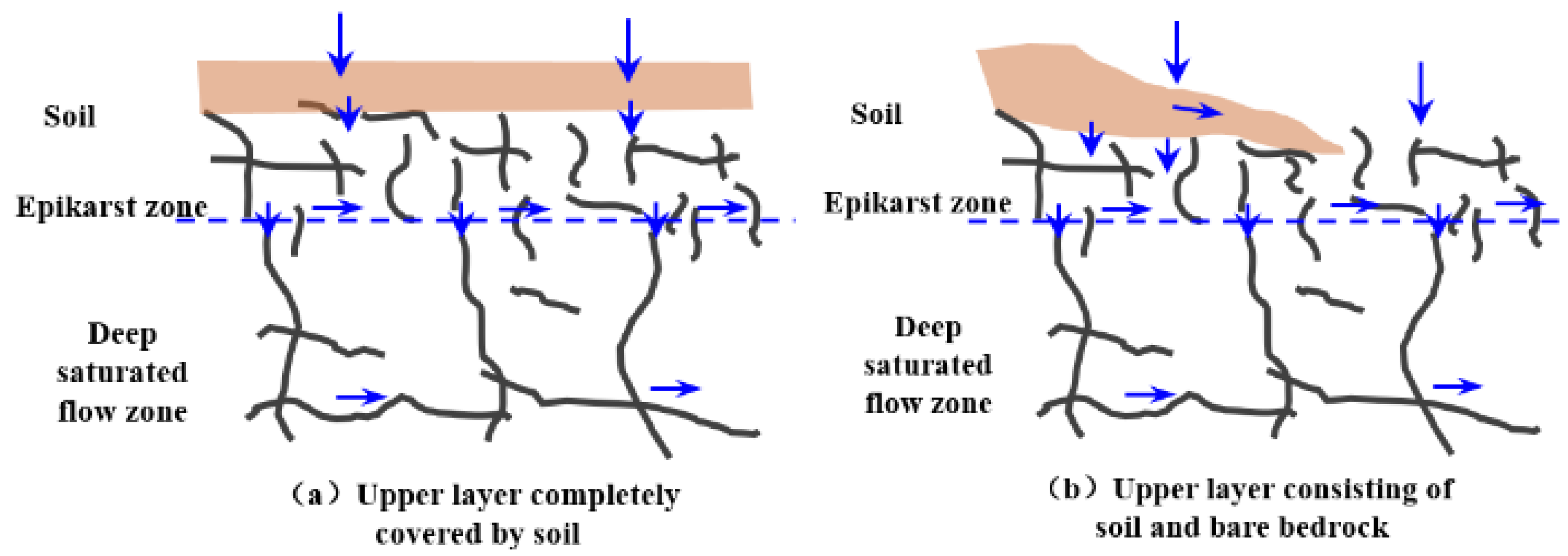
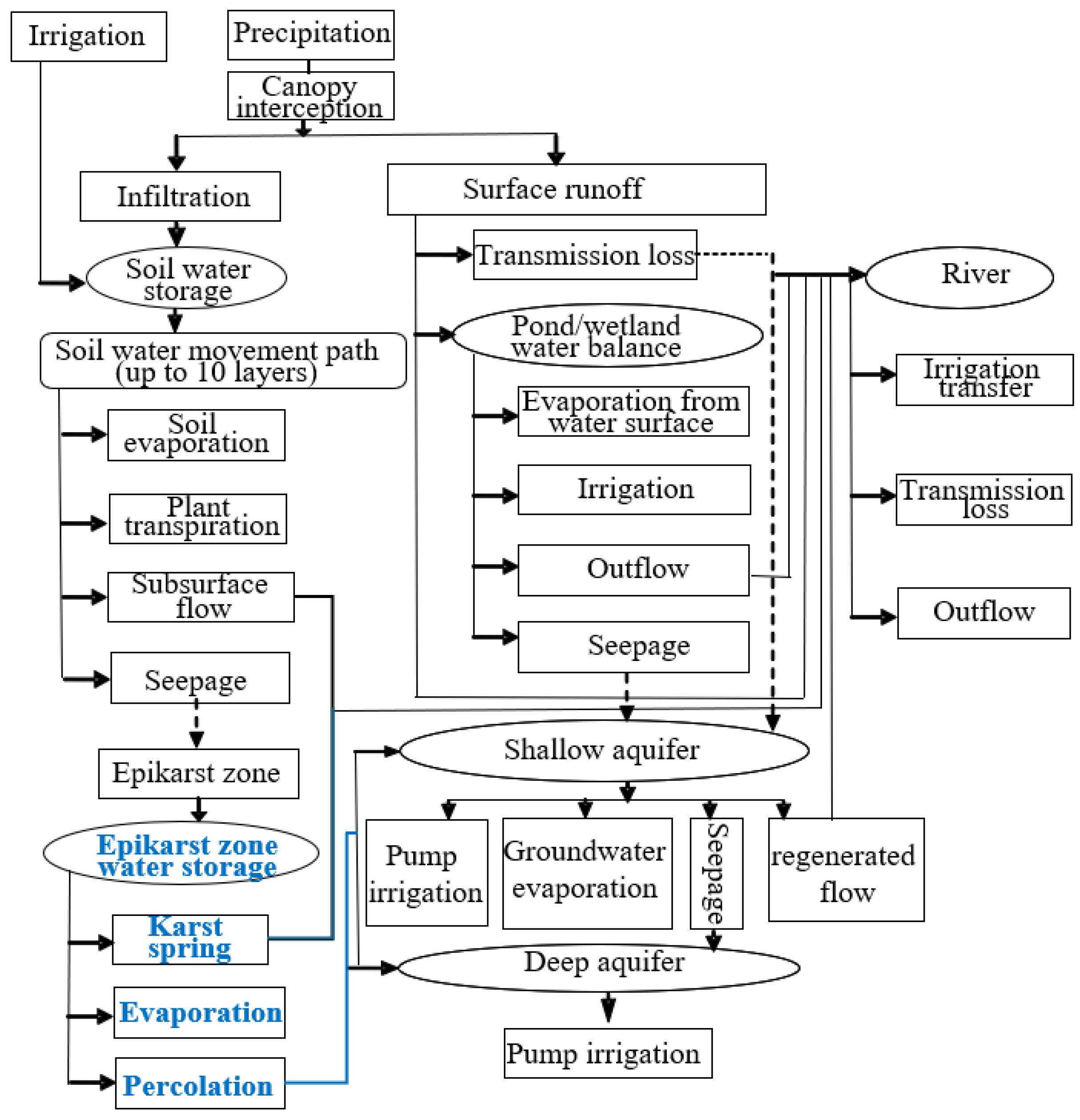
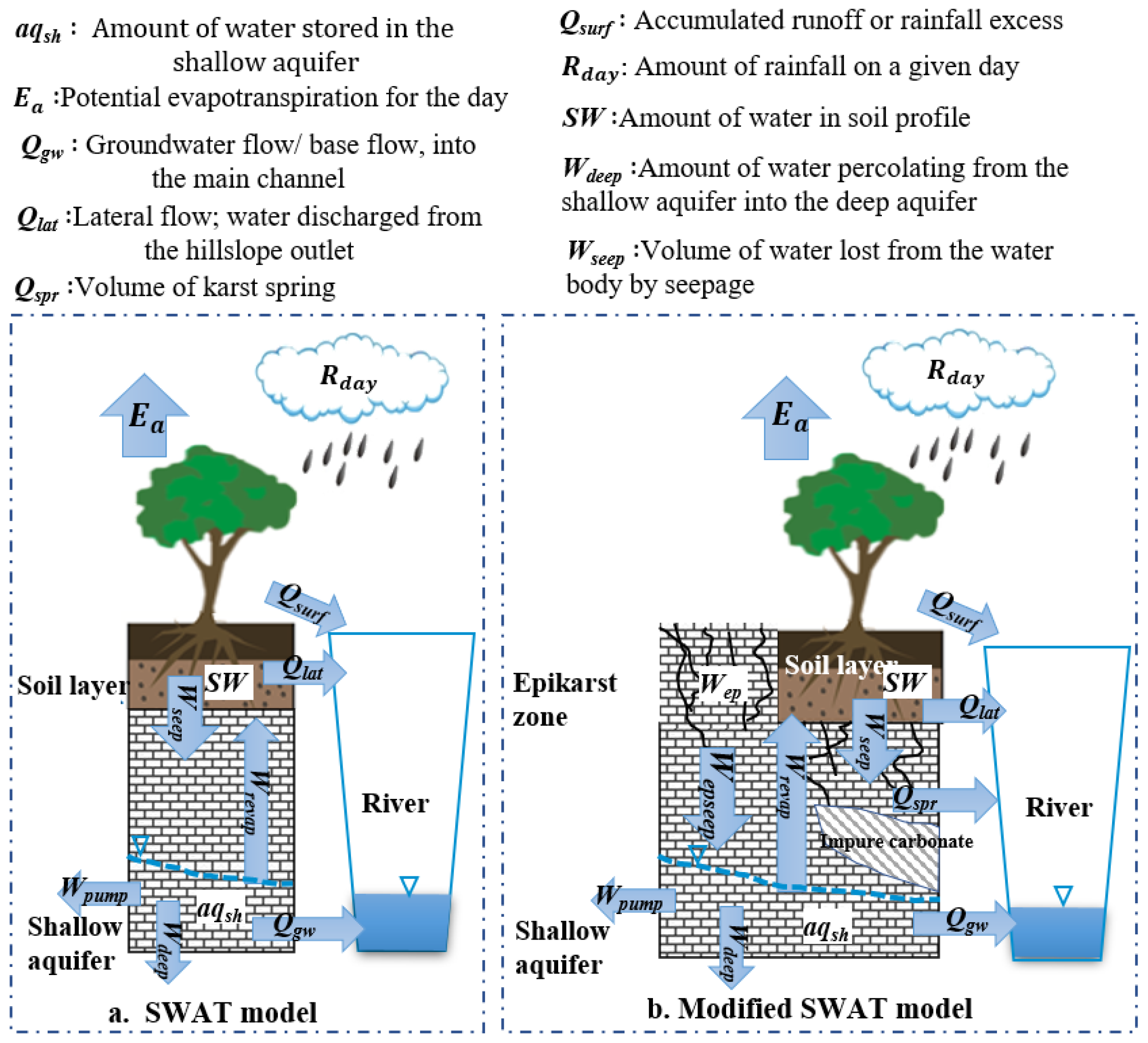
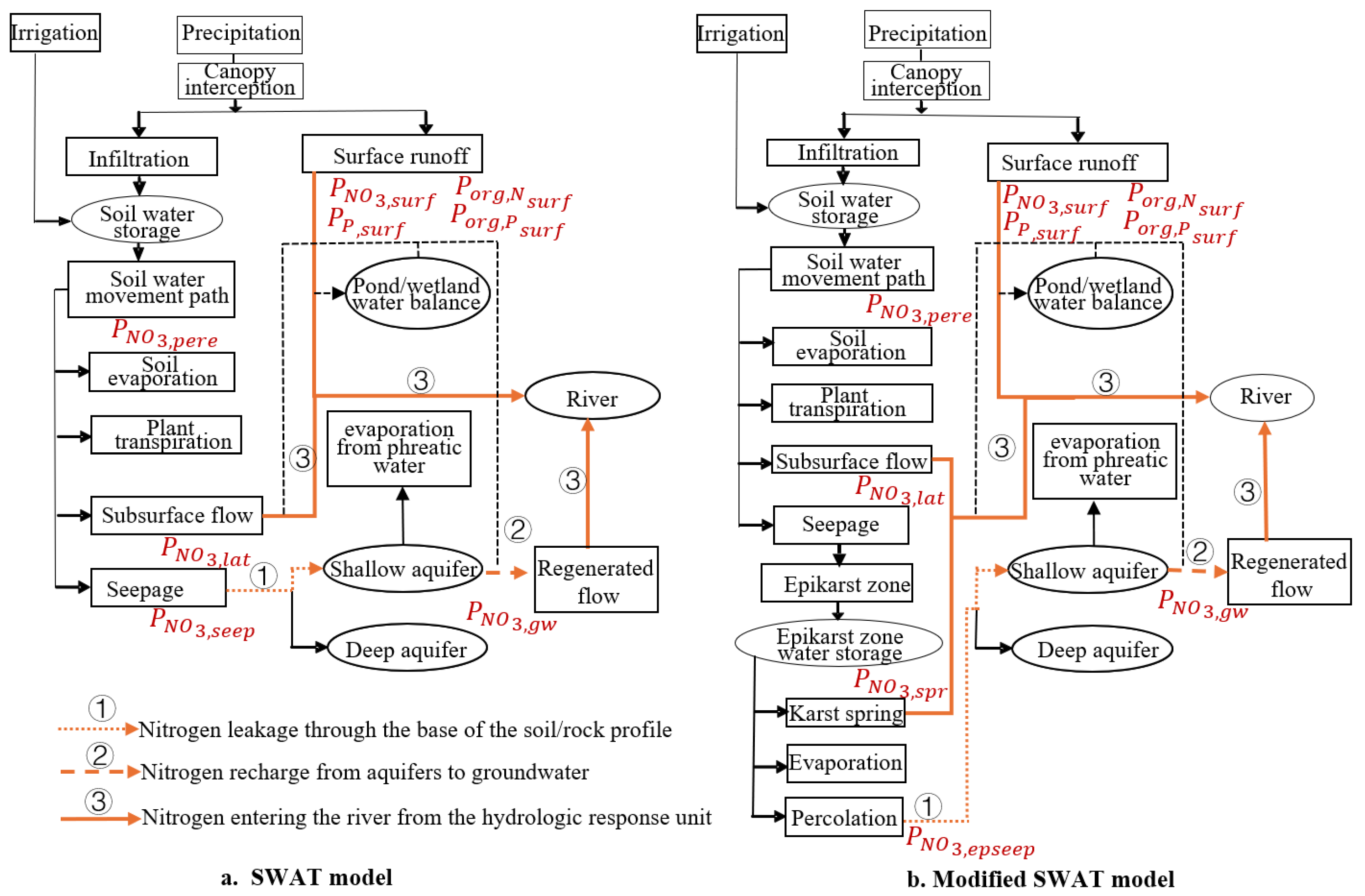
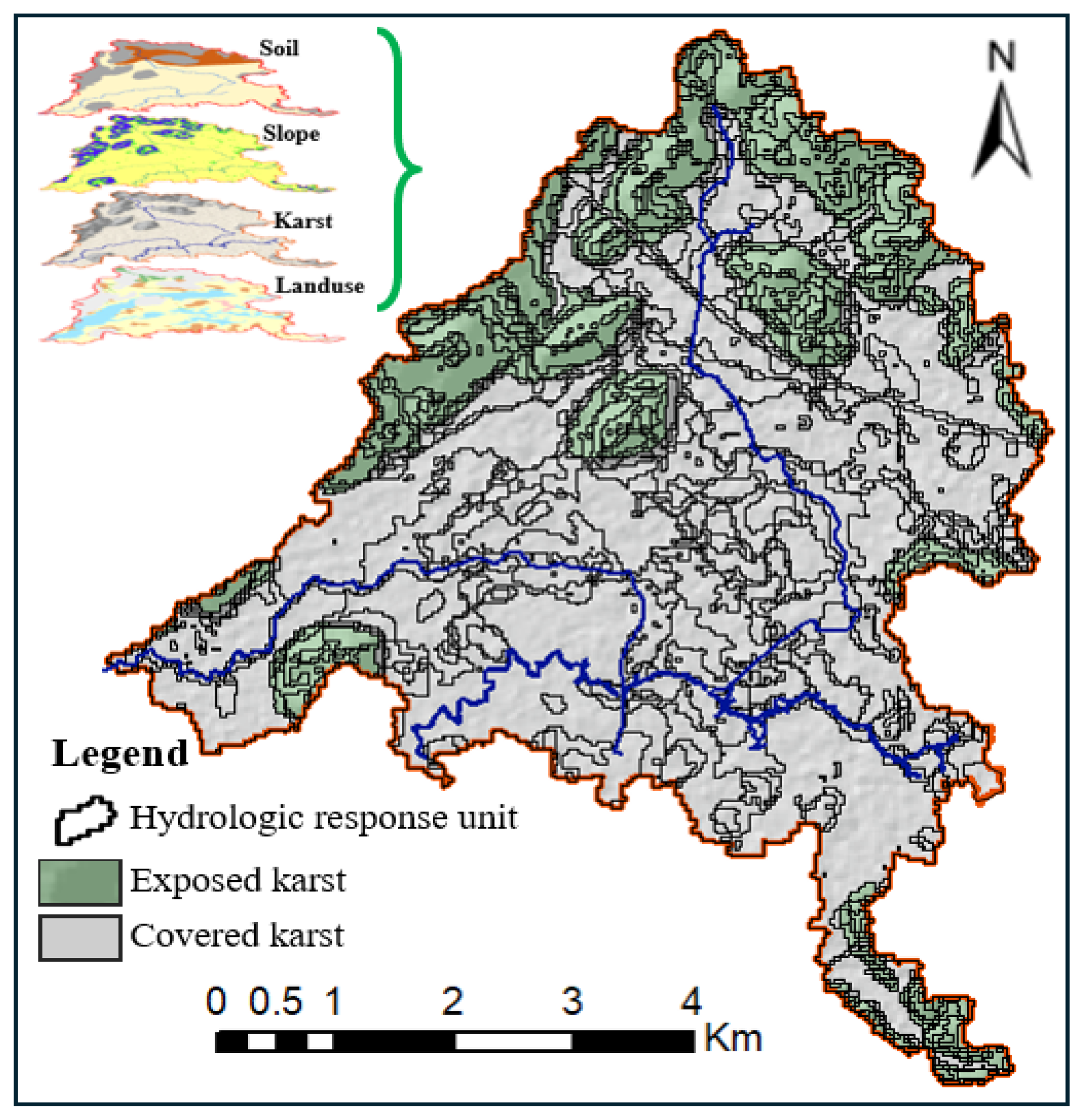

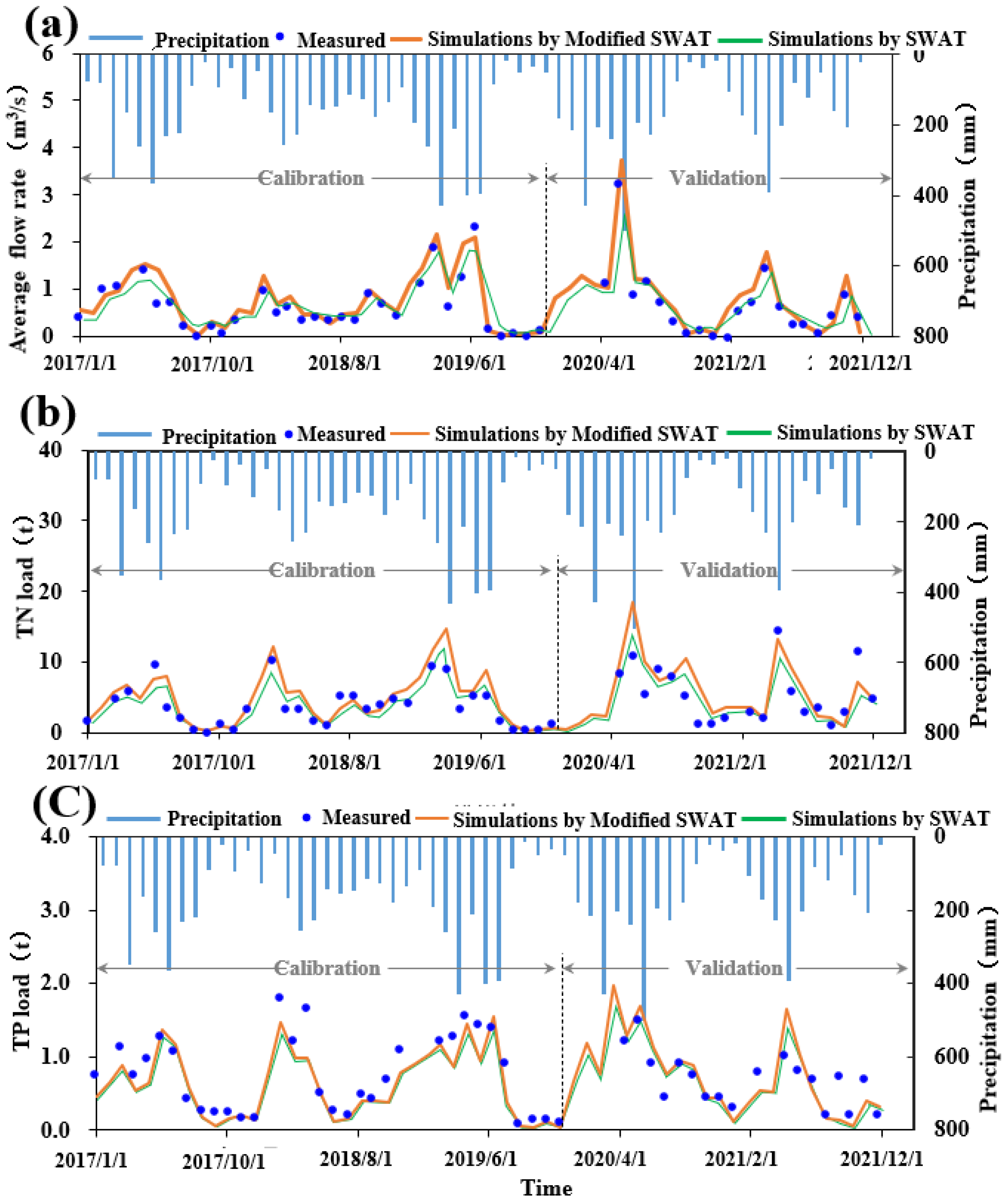
| Notation | Parameter | Range | Final Value |
|---|---|---|---|
| CN2.mgt | Moisture condition Il curve number | 35 to 98 | 75.5 |
| ALPHA_BF.gw | αgw: Baseflow recession constant | 0 to 1 | 0.75 |
| GW_DELAY.gw | δgw: Delay time for aquifer recharge (days) | 0 to 500 | 2.8 |
| REVAPMN.gw | Threshold water level in the shallow aquifer for revap (mm) | 0 to 600 | 578 |
| RCHRG_DP.gw | βdeep: Aquifer percolation coefficient | 0 to 1 | 0.015 |
| CH_N2.rte | Manning’s “n” value for the main channel | 0.01 to 0.3 | 0.13 |
| SOL_AWC.sol | AWCly: available water capacity | 0 to 1 | 0.08 |
| GWQMN.gw | Threshold water level in shallow aquifer for base flow(mm) | 0 to 5000 | 4010.9 |
| SHALLST_N.gw | NO3sh: Amount of nitrate in the shallow aquifer (kg N/ha) | 0.34 to 0.68 | 0.5 |
| GWSOLP.gw | Soluble phosphorus concentration in groundwater flow (mg P/L) | 0.1 to 0.5 | 0.26 |
| ERORGN.hru | ƐN,sed: Nitrogens enrichment ratio | 0 to 5 | 3.55 |
| ERORGP.hru | ƐP,sed: Phosphorus enrichment ratio | 0 to 5 | 1.45 |
| NPERCO.bsn | βNO3: Nitrate percolation coefficient | 0.01 to 1.0 | 0.64 |
| PPERCO.bsn | kd,perc: Phosphorus percolation coefficient (m3/Mg) | 10 to 17.5 | 12.97 |
| BIOMIX.mgt | Biological mixing efficiency | 0 to 1 | 0.027 |
| SWAT | Modified SWAT | ||||||||
|---|---|---|---|---|---|---|---|---|---|
| Year | Flow (106 m3) | TN Load (t) | TP Load (t) | Flow | TN | TP | |||
| Flow (106 m3) | Rate of Increase (%) | Load (t) | Rate of Increase (%) | Load (t) | Rate of Increase (%) | ||||
| 2017 | 22.8 | 40.9 | 6.6 | 23.7 | 3.7 | 44.1 | 7.3 | 6.8 | 3.5 |
| 2018 | 19.3 | 55.7 | 6.8 | 20.1 | 4.0 | 59.5 | 6.4 | 7.1 | 3.7 |
| 2019 | 26.9 | 62.2 | 7.5 | 27.9 | 3.6 | 67.6 | 8.0 | 7.8 | 3.4 |
| 2020 | 33.9 | 75.4 | 8.2 | 35.2 | 5.2 | 83.1 | 9.3 | 8.6 | 4.8 |
| 2021 | 18.4 | 57.1 | 5.7 | 19.1 | 3.5 | 59.8 | 4.5 | 5.9 | 3.2 |
| Model | Year | NSUPQ (Nitrate Migrating to Rivers from HRU Surface Runoff) | NLATQ (Nitrate Migrating to Rivers from Lateral Flow) | NO3GW (Nitrate Migrating to Rivers from Groundwater Flow) | P_GW (Dissolved Phase Phosphorus Migrating to the River from the HRU Groundwater Flow) | SOLP (Dissolved Phase Phosphorus Migrating to the River from Surface Runoff) | OrgN (Annual Amount of Organic Nitrogen) | OrgP (Annual Amount of Organic Phosphorus) |
|---|---|---|---|---|---|---|---|---|
| (kg/ha) | ||||||||
| SWAT | 2017 | 0.011 | 0.451 | 0.023 | 128.219 | 0.514 | 182.235 | 26.181 |
| 2018 | 0.032 | 0.509 | 0.159 | 458.593 | 0.481 | 182.410 | 23.604 | |
| 2019 | 0.011 | 0.345 | 0.106 | 620.035 | 1.743 | 233.084 | 41.187 | |
| 2020 | 0.023 | 0.468 | 0.185 | 719.372 | 2.387 | 223.227 | 35.330 | |
| 2021 | 0.045 | 0.416 | 0.141 | 494.558 | 0.560 | 191.885 | 22.140 | |
| Modified SWAT | 2017 | 0.006 | 0.564 | 0.031 | 130.836 | 0.534 | 260.335 | 26.196 |
| 2018 | 0.023 | 0.606 | 0.198 | 472.776 | 0.490 | 246.501 | 23.611 | |
| 2019 | 0.006 | 0.426 | 0.131 | 645.87 | 1.756 | 306.689 | 41.207 | |
| 2020 | 0.011 | 0.602 | 0.237 | 734.053 | 2.432 | 286.188 | 35.354 | |
| 2021 | 0.022 | 0.501 | 0.174 | 509.854 | 0.598 | 231.187 | 22.281 |
Disclaimer/Publisher’s Note: The statements, opinions and data contained in all publications are solely those of the individual author(s) and contributor(s) and not of MDPI and/or the editor(s). MDPI and/or the editor(s) disclaim responsibility for any injury to people or property resulting from any ideas, methods, instructions or products referred to in the content. |
© 2025 by the authors. Licensee MDPI, Basel, Switzerland. This article is an open access article distributed under the terms and conditions of the Creative Commons Attribution (CC BY) license (https://creativecommons.org/licenses/by/4.0/).
Share and Cite
Dai, J.; Pan, L.; Deng, Y.; Wan, Z.; Xia, R. Modified SWAT Model for Agricultural Watershed in Karst Area of Southwest China. Agriculture 2025, 15, 192. https://doi.org/10.3390/agriculture15020192
Dai J, Pan L, Deng Y, Wan Z, Xia R. Modified SWAT Model for Agricultural Watershed in Karst Area of Southwest China. Agriculture. 2025; 15(2):192. https://doi.org/10.3390/agriculture15020192
Chicago/Turabian StyleDai, Junfeng, Linyan Pan, Yan Deng, Zupeng Wan, and Rui Xia. 2025. "Modified SWAT Model for Agricultural Watershed in Karst Area of Southwest China" Agriculture 15, no. 2: 192. https://doi.org/10.3390/agriculture15020192
APA StyleDai, J., Pan, L., Deng, Y., Wan, Z., & Xia, R. (2025). Modified SWAT Model for Agricultural Watershed in Karst Area of Southwest China. Agriculture, 15(2), 192. https://doi.org/10.3390/agriculture15020192







